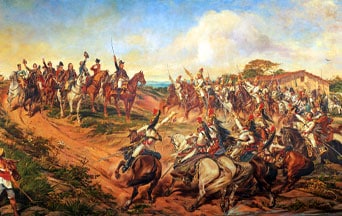
Introduction1
This year, on September 7, marks the bicentennial of Brazil’s independence. More precisely, the day will celebrate the foundation of the Brazilian Empire, which emerged as a sovereign nation.
Celebrations of great anniversaries offer opportunities to reflect on the past and scrutinize the future. We can ask: Where did we come from? How did we get here? Where are we headed?
Inspired by Plinio Corrêa de Oliveira’s perennial lessons, the following reflections are a modest contribution to this dual reflection/inquiry.
I. Gesta Dei per Portugalenses
Pius XII: “Portugal Is a Docile and Precious Instrument in the Hands of Providence”
According to Pope Pius XII, Portugal was called by Divine Providence—along with Spain—to open new worlds to the Church to compensate for the losses She would suffer from the apostasy of much of Europe in the sixteenth-century Protestant Revolution:
“Then, when a series of disastrous events tore much of Europe from the bosom of the Church that had formed it with so much wisdom and maternal love, Portugal, along with Spain, her sister nation, opened huge unknown regions to the mystical spouse of Christ, making up her losses with innumerable children from Africa, Asia and America.”
Eternal and Natural Law: The Foundation of Morals and Law
Further on, the Pontiff states:
“How was it possible that you, though you were few, did so much in holy Christendom? Where did Portugal find the strength to take under its dominion, so many territories of Africa and Asia to extend it to the most distant American lands? Where, if not in that ardent Faith of the Portuguese people, sung about by your greatest poet, and in the Christian wisdom of their rulers, who made Portugal a docile and precious instrument in the hands of Providence, for the performance of such great and beneficial works?”2
An Ancient Crusading Spirit
Portuguese historian, J. Cândido Martins, attributes this zeal for the Faith to the Portuguese sense of being imbued with a providential mission, associated with an ancestral crusading spirit:
“The Portuguese sense of having a providential mission dates back to their ancient crusading spirit. … At a time when part of Europe was separating from Rome, Portugal decidedly extended the limits of Mediterranean Christendom, the Republica Cristiana.”3
Thus, the Portuguese undertook an evangelizing and civilizing epic story that has been referred to as Gesta Dei per Portuclenses or Gesta Dei per Lusitanos,4 an allusion to the Crusades, known as Gesta Dei per Francos. Indeed, the great navigations began as part of the movement to recover the Iberian Peninsula from the followers of Mohammed. Once the Moors were definitively expelled from the “little Portuguese house,”5 tiny Portugal pursued and challenged them in their African lands.
This crusading spirit inspired the kings who promoted those actions and the participating nobles, navigators, warriors, and people who applauded and enthusiastically supported them.
 Learn All About the Prophecies of Our Lady of Good Success About Our Times
Learn All About the Prophecies of Our Lady of Good Success About Our Times
The popes of the time also deemed the Portuguese “feats of Christian daring”6 as crusades: “Their enterprises were regarded in Rome as Crusades for the Propagation of the Faith,” papal historian Ludwig von Pastor writes.7
British historian C. Raymond Beazley adds:
By successive papal bulls, “all prelates and dignitaries of the Church are commanded to preach this Portuguese enterprise [the conquest of Ceuta] as a crusade and to declare to those who should take part in it the same plenary indulgence accorded to Palestine pilgrims. … The same note of crusade is repeatedly affirmed by the pontiffs of the next decades….”8
King Dom Manuel, the Fortunate (b. May 31, 1469 [October 25, 1495] +December 13, 1521), in whose reign Brazil was discovered, was fully aware of this role. The contemporary poet, Gil Vicente, called him the standard-bearer of the Faith or the Catholic Religion.9
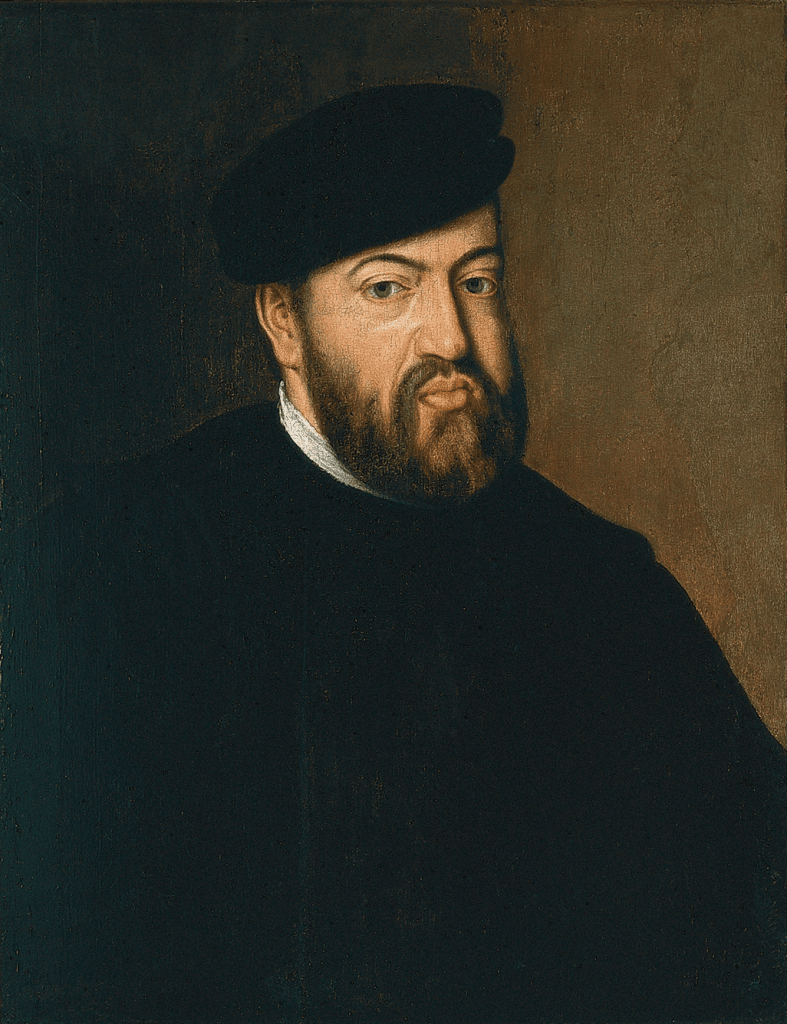
Two factors that most contributed to the Iberian peoples embarking on great navigations in the fifteenth century were their zeal to propagate the Faith and the crusading spirit against the infidels. In search of spices, the Portuguese opened the westward sea route to the Indies. While searching for new lands for the crown, they arrived in Brazil. In all these conquests, they were inspired by the religious ideal of “giving God a greater part of the world.”10
II. Brazil’s Discovery in the Designs of Divine Providence
Brazil’s Role in the “New Christendom”
Plinio Corrêa de Oliveira writes that it was in the designs of Providence that the new Christendom was established in the New World in compensation for the losses suffered in old Europe. It would have two expressions, one of Spanish matrix and the other of Portuguese matrix, each reflecting in their way particular aspects of the Iberian Catholic soul and coexisting harmoniously.11
10 Razones Por las Cuales el “Matrimonio” Homosexual es Dañino y tiene que Ser Desaprobado
However, the great master of the Counter-Revolution emphasizes the Brazilian soul’s “Lusitanity”’ or “Portugueseness”:
These traits inherited from our greatest Portuguese ancestors constitute the typical elements of the Brazilian soul, with important variants inside our homeland. … A Brazil that renounced its Portuguese heritage would no longer be Brazil.12
On a natural level, this ‘Lusitanity,’ tempered by indigenous, African and immigrant influences, constitutes Brazil’s specific contribution to the Christendom of the future.
Let us now see the origin, formation, and development of this Christendom formed under the Southern Cross and called Brazil.
Pius XII: “Brazil Entered History Under the Sign of the Cross of Christ”
Pope Pius XII stated that Brazil “entered history under the sign of the Cross of Christ.”13 Indeed, our country was born under the Sign of the Cross. Thought to be an island, the new land was named Island of the True Cross. Later, when the island was found to be part of a continent, its name was changed to the Land of the Holy Cross.
Thus, Brazil was born Catholic. The first land sighted by the discovering fleet on Tuesday, April 21, 1500, was a hill named Monte Pascoal (Mt. Easter) because it was Easter week.
The first official act performed on Brazilian soil was the celebration of Mass on Easter Sunday, April 26, by the Franciscan Friar Henrique de Coimbra.
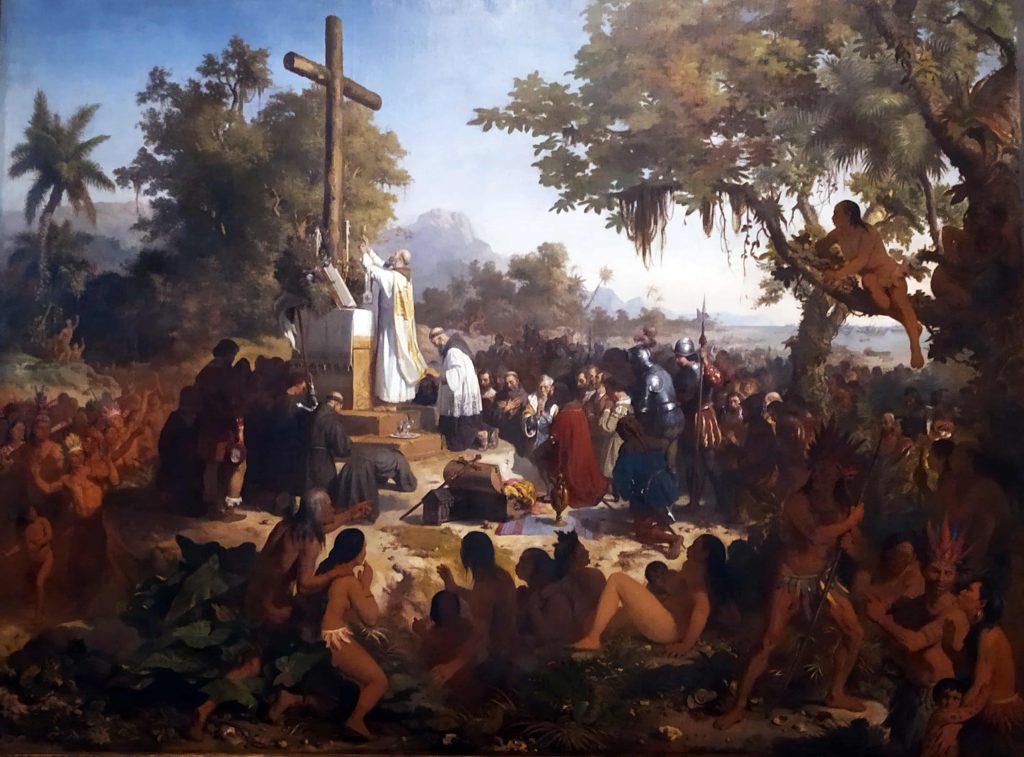
The captain of the fleet that discovered Brazil—Pedro Álvares Cabral, Lord of Belmonte and Warden of Azurara Castle—was a knight of the Order of Christ, as were several of the expedition’s main captains. Their ships’ sails bore the Cross of that order of chivalry.
Even before its discovery, the future continental-sized country was placed under the authority of the Order of Christ. King Dom Duarte (+1438) granted that distinguished Militia spiritual jurisdiction over all Portuguese discoveries, present and future. The concession was renewed by King Afonso V and confirmed by Popes Eugene IV, Nicholas V, Callixtus III, and Sixtus V.14
Aboard the flagship was a statue of Our Lady of Hope, still venerated in Belmonte, Portugal.
Why the Name Brazil?
The name Brazil seems to come from brazilwood, so called because of its splendid red color that resembles the color of brasas, the Portuguese word for embers. In the sixteenth century, brazilwood was highly valued in Europe as a red dyewood to manufacture luxury fabrics such as velvet. It was also highly prized for making violin bows. Thus, brazilwood was in high demand during the Renaissance but was difficult to obtain. When Portuguese navigators discovered what is now Brazil, they immediately saw that brazilwood was very abundant along the coast and inland along the rivers.
Navigators began referring to the region as the “Land of brazilwood,” or simply “Land of Brazil.” Little by little, the name “Brazil” was also used by colonists and Crown employees, prevailing over the other titles.
Later, it was officially adopted, and the new land was called “the State of Brazil.”
Surmounted by a cross, brazilwood started to appear in the territory’s coat of arms (the Cross figured in our homeland’s first coat of arms).
Zealous Evangelization of Natives in the Spirit of the Counter-Reformation
From the early years, missionaries of various religious orders—Franciscans, Carmelites, and Benedictines—dedicated themselves with zeal to evangelizing indigenous peoples, who were soon baptized in large numbers.
Equality and Inequality Among Men
The Society of Jesus brought the spirit of the Counter-Reformation to the new lands and stood out in its missionary work. Those who toiled here include Saint José de Anchieta—the Apostle of Brazil par excellence; the energetic and enterprising Manuel da Nóbrega, the learned João de Azpilcueta Navarro, and the zealous Inácio de Azevedo, who would become one of the Forty Martyrs of Brazil, beatified by Pope Pius IX on May 11, 1854.
A militant Catholicism intervened in the face of foreign heretics. French Calvinists tried to establish themselves in Rio de Janeiro, and Dutch Calvinists tried the same in the Northeast.
A Patriarchal Society with Almost Feudal Characteristics
Settlers settled around the missions, giving rise to towns and cities. São Paulo stands out among them. It was founded in 1554 by the above-cited Jesuits Manuel da Nóbrega and Saint José de Anchieta, then a simple novice.
An organic, rural Christian society gradually developed, based on the patriarchal family and the significant autonomy of municipal authority. 15
Thus was formed a social hierarchy called the “nobility of the land.” The main cities of Brazil gradually received the many honorary rights and privileges granted to the citizens of Porto, Portugal. These honors were extended to Rio de Janeiro residents (1642), São Luís do Maranhão (1645), Salvador da Bahia (1646) and São Paulo (1714).16
A Brilliant Baroque Civilization
At the end of the seventeenth and the beginning of the eighteenth centuries, substantial gold deposits were discovered in various parts of Brazil, especially in the Mantiqueira mountain range area. In addition to the discovery of gold deposits (1695), diamond deposits were also found (ca.1730), hence the name of the Captaincy of Minas Gerais, which means general mines.
Devotion to the Immaculate Heart of Mary
In this mining region, a brilliant Baroque civilization developed. There flourished original schools of architecture, painting, sculpture, and music, centered mainly around the old Vila Rica (today Ouro Preto, founded in 1711) and Diamantina (former Arraial do Tejuco, founded in 1713).
Among the best-known artists, there was Aleijadinho (Antônio Francisco Lisboa), known as “the Crippled One” (1730-1814). He stood out as a talented sculptor, carver and architect. Mestre Ataíde (Manuel da Costa Ataíde, 1762-1830), was a painter and decorator. José Joaquim Emerico Lobo de Mesquita (1746-1805) was a noted organist, conductor and composer.
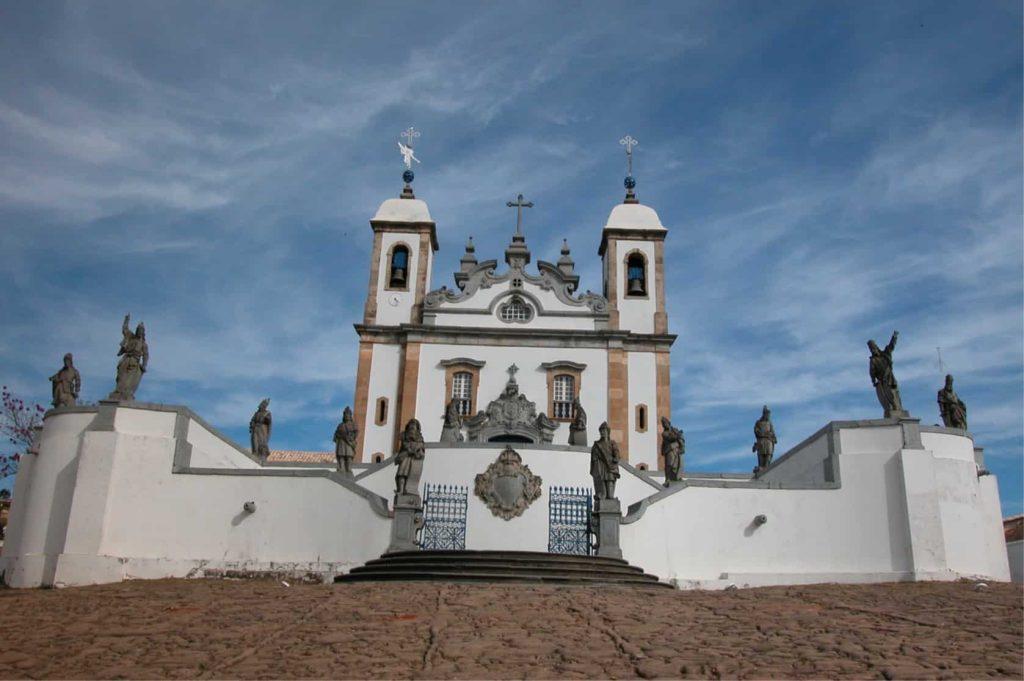
On a smaller scale, this artistic and cultural flourishing also occurred in Rio de Janeiro and other regions called captaincies.
A Genuine Christian Civilization, an Organic Society
A genuine Christian civilization and organic society thus developed in Brazil. It was not a mere reproduction of European civilization or rupture with it. Instead, it was an organic development of that civilization under the circumstances of the New World.
Unfortunately, the Industrial Revolution and other factors interrupted this process. Nevertheless, its roots were too deep for the tree to be uprooted entirely. Some remnants have remained to this day, at least in a latent state.
The Miraculous Finding of the Statue of Our Lady ‘Aparecida’
In October 1717, on the outskirts of Guaratinguetá, a city in the Captaincy of São Paulo, an extraordinary discovery was found in the waters of the mighty Paraíba River. It was a statue later proclaimed Queen and Patroness of Brazil: Our Lady of the [Immaculate] Conception Aparecida.
The discovery unleashed an extraordinary influx of pilgrims to the Patroness’ Shrine. The name “Aparecida” became popular. Many churches and chapels were dedicated to the Virgin who “appeared in the waters.” The ubiquitous presence of her statues and paintings is symptomatic of how much devotion to her is rooted in the Brazilian soul.
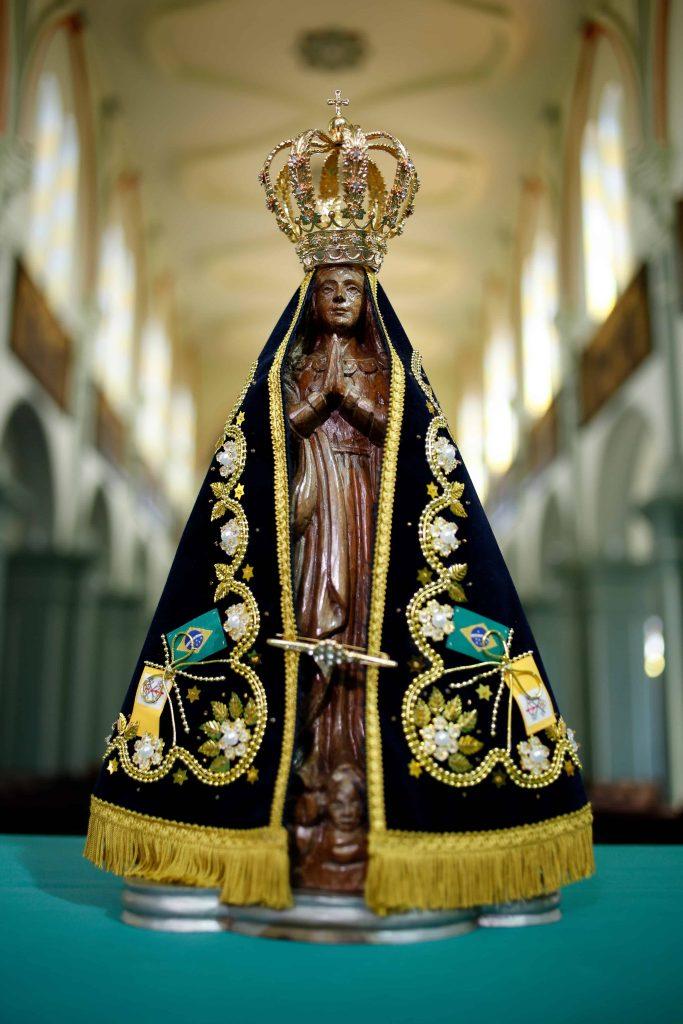
Photo: © sidneydealmeida – stock.adobe.com
Indeed, even non-Catholics consider themselves placed under her protective mantle. People visiting her sanctuary often declare: “I am not Catholic, but I am a Brazilian…”
Thus, it is often said that devotion to Our Lady Aparecida is in the Brazilian DNA.
Slavery, a Shadow in the Picture
A dark shadow in this luminous history is the institution of slavery inherited from other eras. Here too, Brazil is an exception thanks to its twofold quality as a Catholic nation and a daughter of Portugal.
The hardships of slavery were mitigated by Christian charity, aided by that characteristic of the Brazilian soul of feeling compassion for the suffering of others and seeking to alleviate evils that it cannot avoid. The abolition of slavery in the United States caused a fratricidal war that cost over 600,000 lives and incalculable material damage. In Brazil, it took place without major trauma. Successive laws gradually abolished slavery in a process that culminated with the so-called Golden Law, signed by Princess Isabel, Regent of the Empire, on May 13, 1888.
The Only Stable Monarchy in the Americas
A vital feature distinguishes Brazil from its Hispanic neighbors: It was the only country in the Americas to live under a monarchical regime for almost 400 years. It also was the only stable monarchy in the Western Hemisphere, internationally recognized, with an authentic dynasty transplanted from old Europe but fully acclimatized in its own home.
The Land of the Holy Cross’ monarchical vocation manifested itself quite early. In the seventeenth century, it was established as a principality.
Blessed Francisco: Contemplator of the Universe
By a 1645 order of King João IV, the heir to the throne of Portugal would receive the title of Prince of Brazil, just as the heir to the English crown is the Prince of Wales, and the heir to the Spanish crown, the Prince of Asturias. With foresight that could be called prophetic, the same king decided that if the “little Portuguese house”17 was again invaded by foreign forces superior to its own, the king, the court, and the government should transfer to Brazil and continue to rule the Portuguese Empire from there.
Rio de Janeiro, Capital of the Portuguese Empire
This foresight paid off in 1807-8 when Napoleon invaded the Iberian Peninsula. The Prince Regent, Dom João (Prince of Brazil and later King Dom João VI), moved to the Land of the Holy Cross, thus avoiding the fate of the Spanish monarch, deposed and taken prisoner by the French.
Unknowingly, the Prince Regent was fulfilling a secret plan of Divine Providence.
For thirteen years (1808-1821), Rio de Janeiro was the capital of the immense Portuguese empire, which stretched from Europe to America, Africa, Asia, and Oceania.
Kingdom of Brazil
In 1815, Brazil was elevated to the status of a kingdom when it became part of the United Kingdom of Portugal, Brazil and the Algarves.
In 1821, King Dom João VI returned to Portugal, leaving his son and heir, Prince Dom Pedro, aged 23, as Regent of the Kingdom of Brazil. He married the pious Archduchess Leopoldina, daughter of the last Emperor of the Holy Roman German Empire, Francis II (from 1804, Emperor Francis I of Austria).
Empire of Brazil
On September 7, 1822, the young prince, who had grown up in Rio de Janeiro and everyone considered to be Brazilian, was acclaimed Emperor Pedro I.
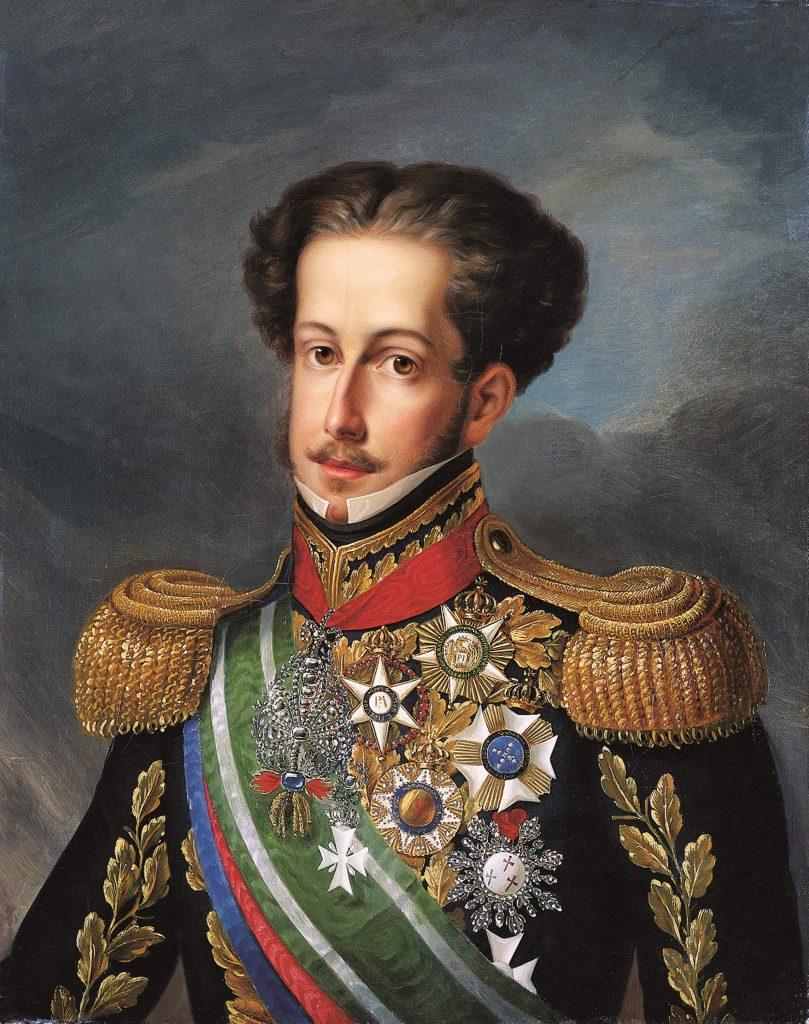
Thus, unlike its neighbors, who broke with Spain through bloody revolutions, Brazil became a sovereign nation in an organic and non-traumatic way, adopting as its own the dynasty that made it great, the House of Braganza.
Pedro I was succeeded by his son Pedro II, who married Princess Teresa Cristina (daughter of King Francis I of the Two Sicilies), nicknamed the Mother of Brazilians. He reigned for nearly half a century, from 1840 until 1889 when a revolutionary military coup overthrew him.
The World’s Fifth Largest and Sixth Most Populous Country
Unlike Spanish America, which split into numerous and often antagonistic nations upon becoming independent, Portuguese America—that is, Brazil—maintained its unity and territorial integrity. As a result, a country with continental dimensions was formed.
Brazil’s territory of 3,286,482 square miles makes it the fifth largest country. It is only smaller than Russia, Canada, China, and the United States.
Its area corresponds to approximately 1.6% of the planet’s entire surface, occupying 5.6% of the earth’s land mass, 20.8% of the size of all Americas and 48% of South America. Its territorial extension gives it a border with every South American country except Chile and Ecuador.18
In addition, Brazil is the world’s sixth most populous country (about 212 million people in 2022).19
The World’s Largest Catholic Country
To be the world’s largest Catholic country has always been Brazil’s greatest glory.
For a long time, “Brazilian” and “Catholic” were almost synonymous. In the first census in 1872, the Empire’s official religion was followed by 99.7% of the population.
How Do We Build an Organic Society?
Unfortunately, despite being the country’s largest single religion, Catholics no longer constitute the vast majority of Brazilians, as the Church increasingly loses faithful to “evangelical” or “Pentecostal” sects—a phenomenon occurring throughout Latin America, according to a Wall Street Journal report.20 It is a sad consequence of a secularized pastoral line imposed on Catholics, especially by liberation theology clerics.
In 2013, despite the reduction in the number of faithful over the preceding decades, Brazil remained the world’s largest Catholic country. According to statistics, Catholics represented 64.6% of the population.21
According to the 2015 Annuarium Statisticum Ecclesiae and the 2017 Pontifical Yearbook, Brazil still had the highest number of Catholics. With 172.2 million Catholics, Brazilian Catholics represent 26.4% of the total number of Catholics. Brazil ranked first among the ten countries worldwide with the highest concentration of baptized Catholics.22
Today, despite a significant decrease, Brazil accounts for about 10% of Catholics across the globe.23
The Largest Portuguese-Speaking Country
Finally, Brazil is the largest Portuguese-speaking country—the fifth most spoken language in the world and the third most spoken European language after English and Spanish. It is the only country in the Western Hemisphere that speaks Portuguese—the language spoken by Our Lady in Fatima.
What are the designs of Divine Providence for Portuguese-speaking America?
III. Brazil’s Future in the Light of the Fatima Message
“In Portugal, the Dogma of the Faith will Always be Kept”—in Brazil as Well?
At Cova da Iria, Our Lady said: “In Portugal, the dogma of the Faith will always be kept.”
Some Fatima commentators believe this promise extends to Brazil because of the close historical, cultural and spiritual connection between the two nations. Prof. Plinio Corrêa de Oliveira shared this opinion. Raymond Cardinal Burke expressed the same opinion on a visit to the Plinio Corrêa de Oliveira Institute headquarters in São Paulo in 2017.
Impressions of the Shroud of Turin
Several arguments are presented to deduce that Brazil was on Our Lady’s mind in Fatima:
In those apparitions, the Mother of God spoke Portuguese, delivering the most important message of our time in that language. She could have appeared in any other country and spoken any other language. However, Portugal was the platform the Virgin chose to speak to the world, and Portuguese was the language she used to convey this message.
To whom is the Fatima Message addressed?
According to Plinio Corrêa de Oliveira, it is destined for the world in general and the Portuguese-speaking world in particular:
“There is among us a whole restoration work to carry out. Providence desires and will bless this work. The fact that the Mother of God chose to speak from Fatima to the whole world makes no other sense. While Her message addresses all humanity, her immediate object is the Portuguese people and those closest to Portugal by blood and history.”24
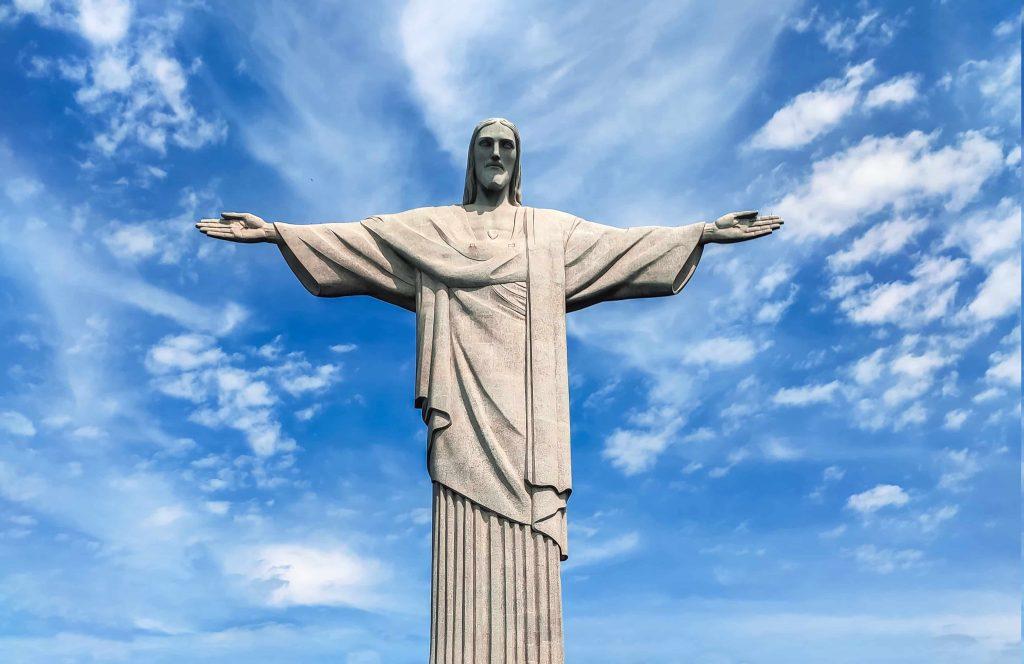
Photo: © Александр Довянский – stock.adobe.com
While other peoples need to translate the Fatima Message into their languages, with the inaccuracies and interpretations inherent to every translation, Brazilians (like other Portuguese-speaking peoples) receive the Virgin’s words in their original version. This appears to indicate that Brazil was also a target of these words distinctively because four out of five of the world’s Portuguese speakers are Brazilian.
Characteristically, the miracle that made possible the canonization of Francisco and Jacinta Marto took place in Brazil (the healing of a Brazilian boy), thus showing an intimate connection between Brazil and Fatima.
The First Rosary Rally Captain Wants You To Join Him
So the great Marian leader could say: “Fatima is the splendid call for the Portuguese-speaking world to establish the Reign of Mary.”25
Aparecida and Fatima, a Connection No One Can Deny
There is an evident connection between Aparecida and Fatima that no one can deny, wrote Prof. Plinio Corrêa de Oliveira.
Brazilians’ great devotion to the Mother of God under the invocation of Our Lady Aparecida is a pledge that the dogma of the Faith will also be preserved in their country. That will happen despite the follies of progressivism and liberation theology, moral decay and universal apostasy from which Brazil is unfortunately not immune.
Are There No Dark Shadows in this Picture?
Yes, there are dark shadows in Brazil’s history and its present, and we are fully aware of them. We earlier mentioned slavery in the past. We now face the disturbing phenomenon of Church apostasies by a growing number of Catholics.
However, the dark shadows have been so emphasized and exaggerated by the enemies of the Church and Christian civilization. Thus, it seems preferable to focus our gaze on the “light that shines in the darkness” rather than the “darkness that seeks to encompass the light” (cf. Jn. 1:5-9).
Videte Vocationem Vestram!
Pope Pius XII eloquently affirmed the great vocation of Brazil in his radio message to Brazilians at the Fourth National Eucharistic Congress in São Paulo in 1942:
Beloved children of Catholic Brazil! Videte vocationem vestram! (1 Cor. 1:26). See and consider well your vocation! God has destined you to be one of the Church’s great Catholic nations in America and the world. This vocation enshrines Brazil’s greatest glory, grandeur, and true happiness.26
Science Confirms: Angels Took the House of Our Lady of Nazareth to Loreto
Hence Plinio Corrêa de Oliveira wrote:
There was a time when world history was dominated by what could be called Gesta Dei per Francos; a day will come when they will write Gesta Dei per brasiliensis.27
Summary and Conclusion
- Brazil was born under the Sign of the Cross.
- Unlike its neighbors in Spanish-speaking America, Brazil did not fragment when she became fully independent. It was a peaceful and natural transition that maintained the reigning dynasty.
- Territorial, political, cultural and religious unity was ensured by two institutions: the altar and the throne. Indeed, the Brazilian soul was shaped by the Catholic religion and the monarchy. Anyone who ignores this will never understand Brazil and Brazilians.
- Devotion to the Blessed Virgin Mary under the invocation of Our Lady of [the Immaculate] Conception Aparecida remains alive despite the current religious crisis.
- The designs of Divine Providence for the Land of the Holy Cross, along with Portugal, are to be the nation where “the dogma of faith” will be kept.
Let us pray to our beloved Patroness that Brazil may turn definitively to her and fulfill its grand vocation.
Footnotes
- A summarized version of this study has been published in Osservatorio Internazionale Cardinale Văn Thuận, Bollettino di Dottrina Sociale della Chiesa, April-May 2022, N. 2—Anno XVIII. It was also transcribed by the Associazione Tradizione Famiglia Proprietà https://www.atfp.it/notizie/306-analisi/2281-passato-splendido-futuro-ancora-piu-bello
- Pio XII, Encíclica Saeculo Exeunte Octavo—A Atividade Missionária Portuguesa, 13 de junho de 1940, n. 8-9. https://www.vatican.va/content/pius-xii/pt/encyclicals/documents/hf_p-xii_enc_13061940_saeculo-exeunte-octavo.html [our translation]
- J. Cândido Martins. “O Mar, as Descobertas e a Literatura Portuguesa” [The Sea, the Discoveries, and Portuguese Literature]. Mensageiro (Braga), May-December 1998. Letras & Letras. http://alfarrabio.di.uminho.pt/vercial/letras/candid02.htm. Acessed January 19, 2022.
- Literaly, the term Gesta Dei per Portucalenses means the epic deeds of God performed through the Portuguese, a reference to a religious crusade. Cf. Luís Filipe Rodrigues Thomaz, “Gesta Dei per Portucalenses,” Revista Internacional Católica—COMMUNIO, ano VIII 1991 • nº 6 pp 501-510. Manuel Leal Freire, “A Europa, segundo Camões,” https://capeiaarraiana.pt/2012/01/07/a-europa-segundo-camoes/ January 25, 2022.
- Camões, Lusíadas, canto VII, est: 14.
- Camões, Lusíadas, canto VII, est: 14.
- Cf. Ludwig Pastor. The History of the Popes. Translated from German and edited by the Rev. Frederick Ignatius Antrobus of the London Oratory. Book I. Alexander VI., 1492-1503. Chapter VI.
- C. Raymond Beazley. “Prince Henry of Portugal and the African Crusade of the Fifteenth Century.” The American Historical Review, Oct. 1910, Vol. 16, No. 1 (Oct. 1910), pp. 11- 23.
- “Alferes da Fé”. Gil Vicente, Auto da Fama (1510). In Obras de Gil Vicente. Lisboa, Centro de Estudos de Teatro – Imprensa Nacional-Casa da Moeda 2002, vol., p.194
- Camões, Lusíadas, canto I, est: 6.
- We could mention numerous texts and speeches by Plinio Corrêa de Oliveira on this topic. We refer here only to the texts we quote in this article: Speech at the Closing of the Fourth National Eucharistic Congress, São Paulo, September 4-7, 1942; SEFAC (Anticommunist Formation Week) Closing Speech, November 2, 1971; articles in Catolicismo: “Passado esplêndido, futuro ainda mais belo” [A Splendid Past, an Even More Beautiful Future], no. 80, August 1957; Gesta Dei per brasilienses, no. 381, September 1982.
- Plinio Corrêa de Oliveira. “Passado esplêndido, futuro ainda mais belo,” cit.
- Pope Pius XII’s Radiomessage to Brazilians on the Fourth National Eucharistic Congress, São Paulo, 1942. https://www.vatican.va/content/pius-xii/pt/speeches/1942/documents/hf_p-xii_spe_19420907_radiomessage-brasile.html 1/23/22.
- Cf. José Carlos de Macedo Soares, Fronteiras do Brasil no Regime Colonial, Rio de Janeiro, 1939, pp. 11-12. Apud Gustavo Antônio Solimeo, “O ‘Muy Bom Fidalgo’ que descobriu o Brasil,” Catolicismo, nº 219, March 1969.
- a href=”#_ftnref15″ name=”_ftn15″>See Homero Barradas, “Capitanias Hereditárias – Primeiro ensaio de um Brasil orgânico,” Catolicismo, n° 131, November 1961. Idem, “A obra civilizadora de Portugal no Estado e no Reino do Brasil,” Catolicismo, n° 261, September 1972, pp. 4-6.
- Homero Barradas, “A obra civilizadora de Portugal,” cit.
- Camões, Lusíadas, canto VII, est: 14.
- Área do Brasil. Brasil Escola. https://brasilescola.uol.com.br/brasil/area-brasil.htm
- “The 10 Most Populated Countries In The World,” Jason Shvili. March 1, 2021, in World Facts https://www.worldatlas.com/articles/most-populated-countries-in-the-world.html#h_44998808310841614600811428
- Francis X. Rocca, Luciana Magalhaes and Samantha Pearson. “Why the Catholic Church Is Losing Latin America,” The Wall Street Journal, January 12, 2022. https://www.wsj.com/articles/why-the-catholic-church-is-losing-latin-america-11641914388
- “Brasil ainda é o maior país católico do mundo, mesmo com redução de fiéis” [Even with Fewer Faithful, Brazil Is Still the World’s Largest Catholic Country]. O Globo, 7/20/2013. https://g1.globo.com/jornal-nacional/noticia/2013/07/brasil-ainda-e-o-maior-pais-catolico-do-mundo-mesmo-com-reducao-de-fieis.html
- “Brasil é o país com o maior número de católicos do mundo” [Brazil Is the Country with the World’s Largest Number of Catholics], Vatican Radio, April 11, 2017.
- “Igreja Católica no mundo.” Wikipédia.https://pt.wikipedia.org/wiki/Igreja_Cat%C3%B3lica_no_mundo January 16, 2022.
- Plinio Corrêa de Oliveira. “Passado esplêndido, futuro ainda mais belo”, art. cit.
- Plinio Corrêa de Oliveira. “Passado esplêndido, futuro ainda mais belo”, art. cit.
- Pope Pius XII’s Radiomessage to Brazilians on the Fourth National Eucharistic Congress, São Paulo, 1942. https://www.vatican.va/content/pius-xii/pt/speeches/1942/documents/hf_p-xii_spe_19420907_radiomessage-brasile.html 1/23/22.
- Speech at the closure of the Fourth National Eucharistic Congress, São Paulo, September 4-7, 1942. Gesta Dei per brasilienses, Catolicismo, no. 381, September 1982.

